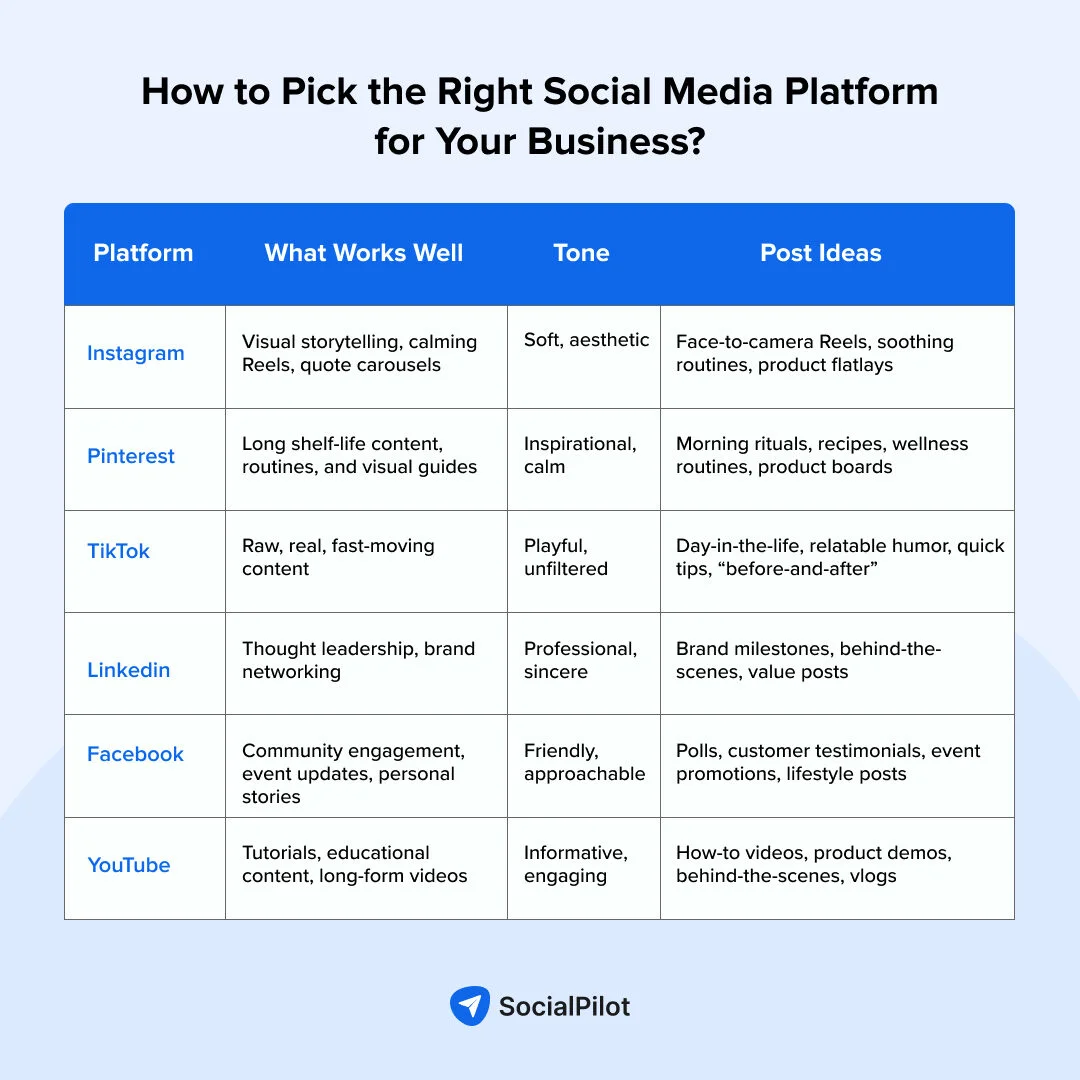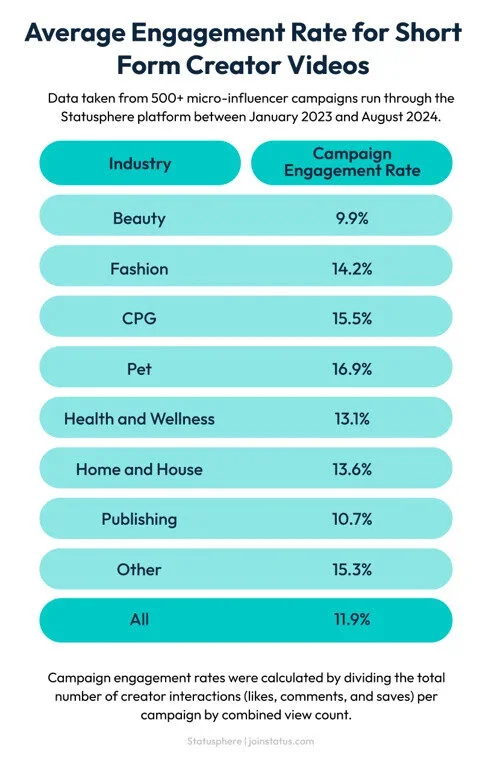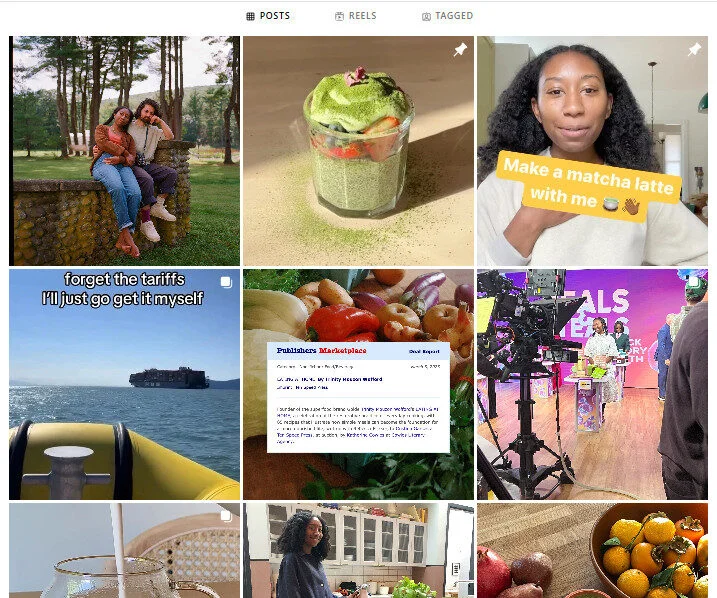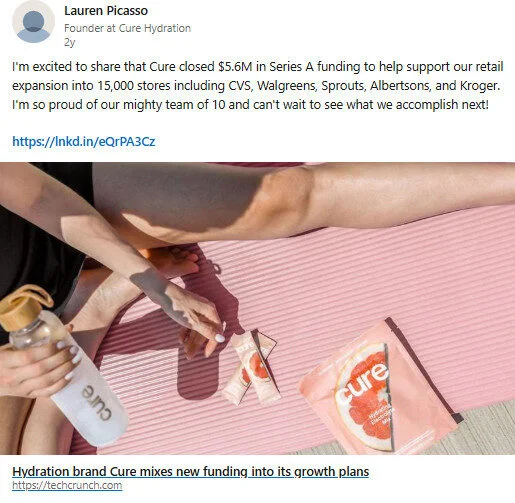If you’re building a wellness brand, you’ve probably felt the pressure to show up on social media. What to post, how often, how to stand out when everything feels saturated.
It’s a lot. But the truth is, social media is where people find you. Research shows that 92% of marketers say their social-media efforts increased exposure. It’s where someone discovers their next nutritionist or books a session because your post made them feel understood.
Social media does the heavy lifting for your brand. From bringing visibility and building trust to helping your brand take up space in a crowded category. Wellness isn’t a small niche anymore. It’s growing fast, and so is the competition. To be remembered, you need to show up with intention.
If you’ve been posting without a plan or feel lost about social media marketing for a wellness brand, don’t worry. This guide will walk you through building a social media strategy that works for you, without the pressure to be everywhere, all the time.
Let’s start there.
You started your wellness brand to help people feel better. But before they trust you, they need to find you, which usually happens on social media.
Without a plan, it’s easy to get lost in the noise. A good strategy helps you show up clearly, consistently, and in a way that feels like you.
Here’s how to build a winning social media marketing strategy.
1. Start with your Brand’s Purpose (beyond the product)
If someone lands on your profile, they should understand what you believe before they ever click “Follow.” That starts with clarity on what your brand stands for, who it helps, and why it exists in the first place.
Let’s say you sell herbal teas. Are you selling better sleep in a cup? Or are you selling a slower, softer way to end the day? Both are valid. But each message attracts a different type of person and leads to a different kind of content.
Your job is to define the lens, not for the algorithm but for your target audience and market.
Try this: Write a one-sentence answer to this question. What do you want someone to feel when they find your brand on social media?
2. Know Who You’re Talking To
“Women, 25–40, health-conscious” isn’t an audience. That’s a vague spreadsheet filter.
You want to know what keeps them up at night, whether they’re overwhelmed moms trying to fit 5 minutes of calm into a chaotic day. Or new gym-goers trying to figure out why they feel burnt out after every workout. What are they searching for at 11 PM when they stumble across your Reel?
Social media is where that moment of discovery happens. The more you understand their life, the more your content will meet them.
Try this: Create three audience snapshots—each with a name, a routine, a frustration, and one thing they’re trying to improve.
3. Pick the Right Platforms (not all of them)
Wellness content performs differently depending on the platform. Instagram works well for visual storytelling, before-and-afters, calming color palettes, and face-to-camera Reels. Pinterest is a slow burn but a great place for recipes, routines, and longer shelf-life content. TikTok moves fast, favors rawness, and rewards experimentation.
You don’t have to be everywhere. Choose the one or two places where your audience already spends time, and where your content format makes sense. If you’re a somatic therapist, a 60-second grounding video on TikTok might travel farther than a graphic quote carousel.
Try this: Look at where your three closest competitors post most often and where they get the most engagement. There’s a clue there.

4. Map content to connection (not just promotion)
Your posts shouldn’t all be “buy this” or “book now.” Social content is a mix of visibility, trust-building, and storytelling. Each post should do at least one of these things:
- Help someone feel seen
- Teach something they didn’t know
- Show behind the scenes
- Reflect your values or beliefs
- Invite engagement
- Highlight how your offer fits their life
For example, instead of just showing your new protein powder, share a post titled “What I wish I knew before switching to plant protein.” That’s insight, relatability, and subtle promotion without sounding salesy.
As you map your content, think about including posts that:
- Showcase your work through portfolio-style posts (ideal if you’re a service-based wellness brand like a coach, therapist, or fitness trainer).
- Pull back the curtain with behind-the-scenes looks—whether it’s how you create your blends, prep for a class, or package an order.
- Offer useful knowledge like design tips (if you’re in product, packaging, or interior wellness), or your take on wellness trends.
- Share stories from others through client testimonials or mini case studies. Let people see how others experienced a transformation with your help or product.
These types of posts convert because they build trust.
Try this: Create three pillars. Types of content you’ll rotate between. For example: Education, Community, and Stories.
5. Create a Content Calendar That Feels Human
Posting daily sounds like a great plan until life happens and you miss a few days. That’s not a strategy. That’s pressure pretending to be consistency.
Start with a realistic calendar. This social media calendar guide can help you map out your posts in advance, spot content gaps, and avoid last-minute stress.
Try this: Set a weekly goal. Maybe it’s two posts and five genuine replies to comments or DMs. Let that be enough.
| Day | Content Type | Theme/Pillar | Notes |
| Monday | Educational post | Education | E.g., “How I built my sleep routine” |
| Wednesday | BTS or Portfolio post | Stories | Packing orders or creating blends |
| Friday | Community or Testimonial | Community | A quote or review from a happy customer |
| Anytime | Reply to comments + DMs | N/A | Set aside 10–15 minutes to engage |
You can also reschedule or reuse high-performing posts with just a few clicks. No spreadsheets needed, just plan around the best time to post for wellness brands to maximize engagement.
Once you’re ready for something more flexible and scalable, SocialPilot’s built-in calendar takes it further. You can batch content when in flow, schedule posts across platforms, collaborate with your whole team, and even plan for different time zones if your wellness brand serves a global audience. You can also reschedule or reuse high-performing posts with just a few clicks. No spreadsheets needed.
Wellness audiences tend to be more skeptical. They’re used to seeing generic ads and polished influencer videos that feel disconnected from real life. That’s why micro-influencer creators with smaller, more engaged followings often see better results in this space.
In fact, micro-influencer campaigns in the Health and Wellness space have an average engagement rate of 13.1%, according to data from over 500 campaigns run through Statusphere (2023–2024). That’s well above the overall average of 11.9%.

When a skincare coach with 8,000 followers shares how your product helped their client with hormonal acne, it feels more honest than a celebrity promo. What matters is that the person is already trusted by their audience, speaks from lived experience, and talks about wellness in a way that reflects your values.
In many Reddit threads like the one below, founders say they got better ROI from these partnerships, primarily when the influencer used the product before it was paid or sponsored. These campaigns work best when there’s a genuine connection, not just a transaction.
Try this: Shortlist creators who regularly talk about the same challenges your product solves. Look for signs of trust: comments like “Thanks for always keeping it real” or replies that turn into actual conversations. Offer a free trial and ask if they’d be open to creating a review—only if it feels right for them.
7. Use Trends That Support Your Brand—Not Distract From It
Jumping on the wrong trend can make your brand feel out of place. But when a trend aligns with your tone and message, it can help your content travel further without losing its meaning.
For example, if you sell sleepwear or calming teas, a slowed-down morning routine trend could naturally show your product in action. If you’re a wellness coach, a trending sound about burnout recovery could open space for an honest, helpful reel. The key is to ask: Does this trend help me say something true? If yes, it’s worth using.
Try this: Before using a trend, test it against your content pillars. Does it teach, connect, or reflect your brand’s perspective? If not, let it go.
Many wellness brands lose momentum because they only post when launching or promoting something. But the most trusted brands always share insights even when not selling.
This could be your take on a common myth (“No, drinking chlorophyll isn’t a detox”), a checklist for beginners (“3 signs your workout is too intense”), or even a thought you had during a client session. These posts build a sense of care. They position your brand as a guide, not just a product.
Try this: Block off time each month to turn your everyday knowledge into content—answers to questions you often hear, mistakes you see people make, or reflections from your routine. These are the pieces people save, share, and remember.
9. Use Voice-of-Customer Insights to Shape Your Content
Wellness audiences are not one-size-fits-all. Your product might help with gut health, but the way you talk about it should depend on who you’re speaking to, and how they describe their problems.
Instead of relying on broad demographics like “health-conscious millennials,” dig into voice-of-customer insights. That means listening to how your ideal clients describe their struggles, what they Google late at night, and what words show up in their comments and DMs.
For example, “Take care of your gut health” sounds nice, but it’s vague. A post that says, “Your 3 p.m. bloat isn’t normal—it’s your gut asking for help,” speaks directly to someone’s lived experience. This kind of specific, relatable language helps your content stand out in a saturated wellness feed.
Let this insight shape:
- Your messaging (use their words, not yours)
- Your post topics (answer what they’re already wondering)
- Your format (video, carousel, or story—depending on where they hang out)
Try this: Create three audience profiles. Include not just who they are but how they talk, what they save, and what they’re trying to fix. Use that to decide what you post—and how you say it.
It’s one thing to hear what works. It’s another to see it in action. When you’re building a social media strategy, real-world examples show you how brands use different platforms to grow, connect, and sell without sounding pushy.
Let’s break down how some wellness brands have made specific platforms work for them. We’ll start with Instagram.
1. Golde
Platform: Instagram
Brand: Golde
Golde is a Brooklyn-based wellness brand known for its superfood blends, such as matcha, turmeric, and cacao. Their Instagram is a great example of how wellness brands can build trust, educate gently, and sell without sounding pushy.

What They’re Doing Well:
- The feed looks real and not like an ad:
Golde doesn’t use flashy graphics or overly edited shots. Most of the content looks like it was taken in someone’s home with natural light. That’s important because wellness is personal. Their photos (like morning matcha, quiet corners, or a slice of cake) feel cozy and human, not staged. - Focus on everyday use:
You’ll often see the product mid-use, like matcha being whisked, a latte being poured, or a blue smoothie being mixed. Instead of focusing on packaging or benefits in every post, Golde leans into lifestyle. They show you how their product naturally fits into your day. That’s what makes the feed scroll-stopping. - Low-pressure, high-value content mix:
Not every post is selling something. Some are just calming videos, others show behind-the-scenes prep, or celebrate milestones (like their 7th birthday cake). This variety keeps followers engaged and builds trust. You don’t feel like you’re constantly being pitched. - Community moments:
Golde often reposts user photos or responses. It makes followers feel seen. Even their Stories highlight small things like tea rituals, product tips, or quick Q&As. That two-way feeling builds loyalty.
What You Can Learn:
- Low-fi can work better than glossy: Wellness brands do well when content feels honest. Golde’s lighting, setups, and vibe are proof.
- Don’t oversell: Teach, show, and share. Let the product naturally shine in real-life use.
- Use a calm, helpful voice: Captions that teach, comfort, or invite conversation work better than product dumps.
- Rotate content types: Golde mixes recipes, reviews, lifestyle shots, BTS, and milestones.
- Highlight your people: Reposting your customer photos, answering questions, or showing DMs can make your brand feel approachable.
2. Selfless by Hyram
Platform: YouTube
Brand: Selfless by Hyram
Selfless by Hyram is a skincare brand co-created by Hyram Yarbro, a YouTuber known for breaking down skincare in an easy-to-follow way. His channel is a mix of skin advice, personal takes, and helpful breakdowns, not just product talk.

What They’re Doing Well:
- He teaches, then mentions the product:
Most of his videos focus on skin issues people care about, such as clogged pores or sun protection. He explains what helps, shares what to avoid, and includes his products where they make sense. The focus is always on helping the viewer first. - The tone is very casual and honest:
He talks like he’s chatting with a friend. That kind of tone makes the brand feel more relaxed and welcoming. It doesn’t feel like he’s trying to sell something every second. - Videos show routines, not just features:
The product is used in everyday situations, such as morning routines or budget skincare guides. Instead of simply listing ingredients, he shows how someone might use it at home. - He brings his community into the content:
Sometimes he reacts to people’s skincare videos, answers their questions, or shares updates based on what his audience asks for. That makes viewers feel like their voice matters.
What You Can Learn:
- Educate first, sell second: Viewers come for value and not ads. Hyram built trust before introducing products.
- Keep your tone human: Wellness content performs better when it sounds like a real person talking, not a brand pushing features.
- Show how products fit into real life: Use-case videos, tutorials, or routine walk-throughs are better than stand-alone promotions.
- Involve your audience: UGC, Q&As, or reply-style videos build community and long-term loyalty.
3. Cure Hydration
Platform: LinkedIn
Brand: Cure Hydration
Cure Hydration is a plant-based electrolyte drink mix brand founded in 2019 by Lauren Picasso. The company emphasizes clean, science-backed hydration solutions and has expanded its retail presence to over 15,000 stores nationwide, including CVS, Walgreens, and Sprouts.
What They’re Doing Well:
1. Sharing Business Wins:
They post big updates, like when they raised $5.6 million in funding or opened more stores. This builds trust and shows that they’re growing fast. It also gives other brands a peek into what it takes to scale.

2. Founder Presence:
Lauren (the founder) posts on her profile, too. She shares behind-the-scenes and how they’re building the company. It makes the brand feel more human.
3. Highlighting Achievements:
The company celebrates recognitions like being listed in the Inc. 5000, ranking No. 568 in 2024. Such accolades enhance credibility and showcase the brand’s rapid expansion.
4. Emphasis on Values:
Cure highlights that it is a woman-led team and that it cares about clean, honest ingredients. Their LinkedIn shares how the company is built with care, from the science behind the product to the team behind the scenes.
What You Can Learn:
- Post your wins: It helps people take your brand seriously.
- Be present as a founder: It helps your brand feel more human.
- Talk about your values: Share why you started and what you care about.
- Show progress: People love to see growth. It builds trust.
You Don’t Need To Be Everywhere. Just Be Clear
Most wellness brands think social media is about being everywhere and looking polished. But what builds trust is showing up with purpose. That could mean fewer posts, slower growth, or taking time to listen before responding. And that’s okay.
If you’re figuring out what to share or how often to show up, start with what feels sustainable for your audience and your team. A consistent presence that respects your values will do more for your brand than chasing likes ever will.Tools like SocialPilot can help simplify the process. You can plan your content across channels, stay organized, and avoid the last-minute rush that usually drains creativity. Instead of reacting to trends, you can post with intention and still keep track of what’s working.



